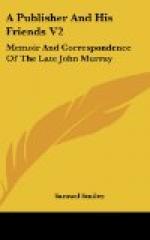CHAPTER XXVIII
MOORE’S “LIFE OF BYRON”
In 1827 or 1828 Mr. Hanson, the late Lord Byron’s solicitor, wrote to Murray, enquiring, on behalf of the executors, whether he would be willing to dispose of his interest in the first five cantos of “Don Juan.” Mr. Murray, however, had long been desirous of publishing a complete edition of the works of Lord Byron, “for the public,” he wrote, “are absolutely indignant at not being able to obtain a complete edition of Lord Byron’s works in this country; and at least 15,000 copies have been brought here from France.” Murray proposed that those copyrights of Lord Byron, which were the property of his executors, should be valued by three respectable publishers, and that he should purchase them at their valuation. Mr. Hobhouse, to whom as one of the executors this proposal was made, was anxious that the complete edition should be published in England with as little delay as possible, but he stated that “some obstacles have arisen in consequence of the Messrs. Hunt having upon hand some hundred copies of their two volumes, which they have asked a little time to get rid of, and for which they are now accounting to the executors.”
Murray requested Mr. Hanson to apply to the executors, and inform him what sum they required for the works of Lord Byron, the copyrights of which were in their possession. This they refused to state, but after considerable delay, during which the Hunts were disposing of the two volumes, the whole of the works of Lord Byron which were not in Mr. Murray’s possession were put up to auction, and bought by him for the sum of L3,885. These included the “Hours of Idleness,” eleven cantos of “Don Juan,” the “Age of Bronze,” and other works—all of which had already been published.
Notwithstanding the destruction of Lord Byron’s Memoirs, described in a previous chapter, Murray had never abandoned the intention of bringing out a Biography of his old friend the poet, for which he possessed plenteous materials in the mass of correspondence which had passed between them. Although his arrangement with Thomas Moore had been cancelled by that event, his eye rested on him as the fittest person, from his long intimacy with the poet, to be entrusted with the task, for which, indeed, Lord Byron had himself selected him.
Accordingly in 1826 author and publisher seem to have drawn together again, and begun the collection of materials, which was carried on in a leisurely way, until Leigh Hunt’s scandalous attack on his old patron and benefactor [Footnote: “Recollections of Lord Byron and some of his Contemporaries,” 1828. 4to.] roused Murray’s ardour into immediate action.
It was eventually resolved to publish the Life and Correspondence together; and many letters passed between Murray and Moore on the subject.
From the voluminous correspondence we retain the following extract from a letter from Moore to Murray:




